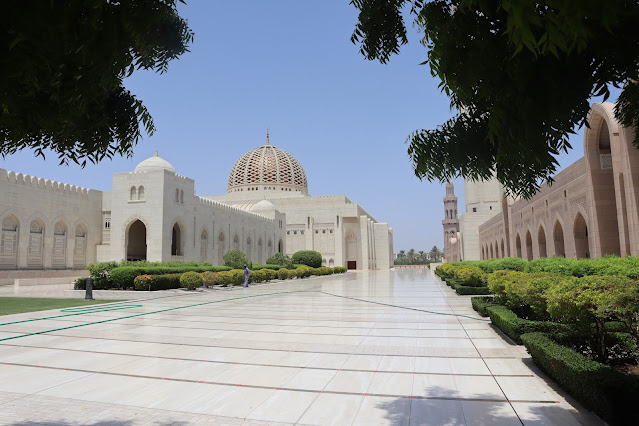Sultan Qaboos Grand Mosque, Muscat
Sultan Qaboos Mosque: A Symbol of Oman's Heritage and Progress
The Sultan Qaboos Mosque is the largest and most magnificent mosque in Oman, located in the capital city of Muscat. It was inaugurated by the late Sultan Qaboos bin Said Al Said in 2001, as a gift to the nation to celebrate his 30 years of reign. The mosque is a masterpiece of Islamic architecture, blending traditional Omani elements with modern features and materials.
The mosque covers an area of 416,000 square meters, with a capacity for 20,000 worshippers. It has five minarets, representing the five pillars of Islam, with the main minaret reaching 90 meters in height. The mosque also has a stunning dome, which rises to 50 meters above the floor and is decorated with intricate patterns and calligraphy.
Some interesting facts about the mosque are:
- The mosque was built after a competition for the best design was held in 1993. The winning design was a combination of Islamic, Middle Eastern and Omani architectural styles.
- The mosque was built using 30,000 tonnes of pink sandstone imported from India, as well as local granite and white marble.
- The mosque took six years and seven months to build, and was completed in May 2001.
- The mosque is not only a place of worship, but also a cultural and educational center. It has a library, a lecture hall, a museum and a garden.
One of the most impressive aspects of the mosque is the prayer carpet that covers the floor of the main prayer hall. It is one of the largest single-piece carpets in the world, measuring 70 by 60 meters and weighing 21 tons. It was hand-woven by 600 Iranian craftsmen over four years, using 28 colors of wool and cotton. The carpet features a variety of Persian designs, such as medallions, flowers and vines.
Another remarkable feature of the mosque is the chandelier that hangs above the main prayer hall. It was once the world's largest chandelier, measuring 14 meters in height and 8 meters in diameter. It weighs 8.5 tons and contains 1,122 lamps and 600,000 Swarovski crystals. The chandelier reflects the light from the stained glass windows, creating a dazzling effect.
Some more facts about these features are:
- The prayer carpet contains 1.7 billion knots and took four years to produce. It brings together the classical Persian Tabriz, Kashan and Isfahan design traditions.
- The chandelier was made by Faustig from Germany and took four years to complete. It has a remote control system that allows it to change colors according to different occasions.
The mosque also has a library, a lecture hall, a museum and a garden. The library contains over 20,000 books on various subjects, including Islamic studies, history, science and art. The lecture hall hosts seminars and workshops on religious and cultural topics. The museum displays artifacts and manuscripts related to Oman's history and heritage. The garden is a peaceful oasis with fountains, palm trees and flowers.
Some additional facts about these facilities are:
- The library has a collection of rare manuscripts dating back to the early Islamic era. Some of them are written on parchment, leather or papyrus.
- The lecture hall can accommodate up to 400 people and has state-of-the-art audiovisual equipment. It also has an interpretation system for different languages.
- The museum has a section dedicated to Sultan Qaboos' personal gifts from various countries and leaders. Some of them include swords, daggers, coins, stamps and medals.
The Sultan Qaboos Mosque is not only a place of worship, but also a symbol of Oman's heritage and progress. It showcases the country's rich culture and history, as well as its modern achievements and aspirations. It is a testament to the vision and legacy of Sultan Qaboos, who transformed Oman into a prosperous and peaceful nation.





.jpg)


Comments
Post a Comment